The Udvar Hazy also has a collection of recon cameras, gun cameras and bomb sights.
milescl
Well-known

Leica DRP 35mm Rangefinger Film camera & 1:1.5 f=5cm Lens Sld As Is | eBay
Buttons work. Lens has no fungus may have small scratch. Sld as is.
www.ebay.com
Another 5.8cm in disguise?
Irregular production- but has standard spanner slots on front and back, and does not have an indexed RF Cam.
I think it is a 5cm f1.5.
I think it is a 5cm f1.5.
dexdog
Mentor
hard to say if this is 5.8cm or not. lens does not appear to be coated but is T-marked, has a post-WW2 CZJ serial number, looks to be an "irregular production" lens. my guess would be a post-war hack of a contax mount lens i to an ltm body. The rear lens group does not exhibit the 6 slots that i have seen on a few 5.8cm lenses. I cannot check serial number by theile's book be cause i am outta town at the moment
milescl
Well-known
Very odd engravings. I’ll ask the seller for clearer photos of the barrel.
TenEleven
Well-known
The other thing that speaks against it being a 5.8cm is the size. Unless the seller has absolutely enormous hands, the size looks more like a standard 5cm focal length to me.
The 5.8cm is notably larger in both width and height.
The 5.8cm is notably larger in both width and height.
Räuber
Established
It really would have helped if the seller showed an image where you see the lens from the side. The front (name) ring is not engraved by CZJ. The focus barrel is engraved with the same (font) numbers. Not a Russian clone but a German one. As all others here have already pointed out this is an irregular production Sonnar for sure.
Räuber
Established
Yeah, I know that I wrote I would never buy one... but... the offer was to good to give it a pass...
I bought a Sonnar 5,8cm f/1,5. I've got it yesterday. It is different to all other 5cm Sonnar lenses. Have a look.
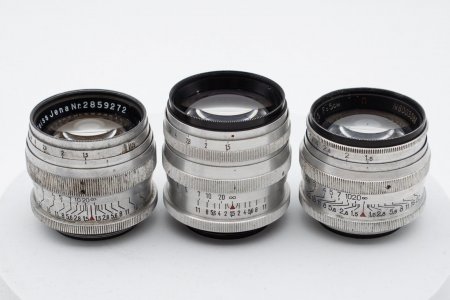
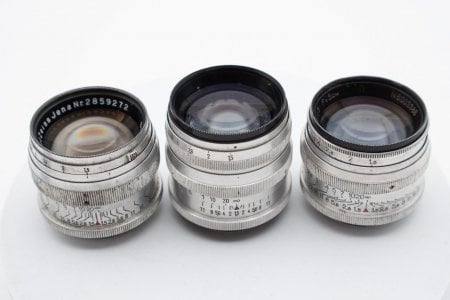
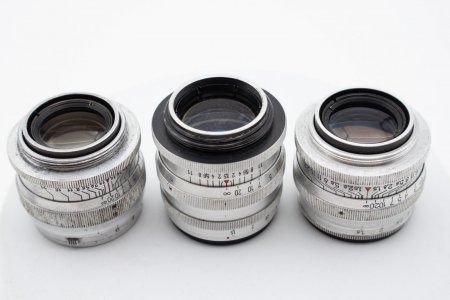
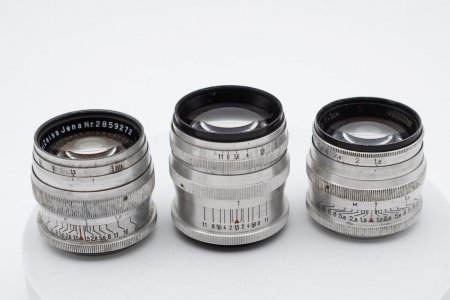
The 5,8cm is the one in the middle. Left LTM Sonnar 5cm f/1,5 wartime, right 1960 Jupiter-3.
I know almost every 5,8cm f/1,5 Sonnar looks different from the other. But there are some common traits. My copy is unlabeled but I knew from the start that the seller was wrong offering it as a 5cm f/1,5. Lucky me so I've got it for cheap. It was sitting on Ebay for weeks and month and despite there was a lot of interest nobody cared to buy it. Meanwhile his brothers and sisters are offered for whopping 4 digit prices. Lucky me.
The interesting details.
I bought a Sonnar 5,8cm f/1,5. I've got it yesterday. It is different to all other 5cm Sonnar lenses. Have a look.




The 5,8cm is the one in the middle. Left LTM Sonnar 5cm f/1,5 wartime, right 1960 Jupiter-3.
I know almost every 5,8cm f/1,5 Sonnar looks different from the other. But there are some common traits. My copy is unlabeled but I knew from the start that the seller was wrong offering it as a 5cm f/1,5. Lucky me so I've got it for cheap. It was sitting on Ebay for weeks and month and despite there was a lot of interest nobody cared to buy it. Meanwhile his brothers and sisters are offered for whopping 4 digit prices. Lucky me.
The interesting details.
- max aperture of f/11 (as all of the 5,8cm / 6cm Sonnars)
- filter size 40,5
- 12 rounded aperture blades
- weight 173 gr
- max diameter 48,15 mm
- total length at infinity 51,25 mm
- total length at 1m 52,45 mm
- length from mount at infinity 43,75 mm
- length from mount at 1m 48 mm
- 2 aperture scales and marks (like the Opton-Zeiss Sonnars)
- top part of the lens / aperture ring rotates as you focus the lens
- black painted LTM thread and bottom
- rear spanner ring with 6 slots
- black filter rim
- red dot as aperture mark
- small m at distance scale
- air bubbles in rear glass elements
- weak anti reflection coating
- not as sharp as the wartime LTM Sonnar 5cm f/1,5
- not as contrasty as the wartime LTM Sonnar 5cm f/1,5
- sharpens up nicely stopped down
- reaches infinity
- narrower FOV than the wartime LTM Sonnar 5cm f/1,5 (probably the 5,8cm are right)
- very funky sharpness point (more on this later)
Räuber
Established
First of all my copy of the Sonnar 5,8cm f/1,5 has some strange sharpness issue. At the point where it should be in focus it becomes unsharp. I have never seen such kind of thing. When you focus from infinity to in-focus you notice that you are almost there and then it becomes unsharp and then it gets sharper again just to become unsharp because you are now leaving the in-focus area. This is most noticable wide open. But even at f/2 it is quite soft when in focus. This makes it hard to focus even or especially using a mirrorless camera and when zoomed in to a high level.
I tried to visualize this effect. I compared my Sonnar 5,8cm f/1,5 with a wartime LTM Sonnar 5cm f/1,5 and a post-war Biotar 5,8cm f/2.



For this test I stood in front of a large black and white picture and did 5 images at 5 different focus positions. From totally out of focus the lens focused on far away to in-focus and then to totally out-of focus focused very close.
a -> lens focused almost to infinity, b -> focus almost achieved, c -> in focus, d -> focused closer than in focus, e -> lens focused very close
You can clearly see that at point c (the in-focus point) the Sonnar 5,8cm is visibly softer than the focused before and after this focus point. Believe me this is no shake or misfocus. The out-of-focus area on the close side looks suspicious too. Does anyone have an explanation? Is my copy faulty?
I did some comparison shots with those 3 lenses yesterday. Here is one set.
Sonnar 5,8cm F/1,5 at @1,5 @2 @2,8 @5,6

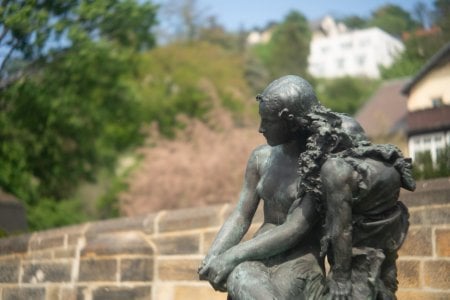
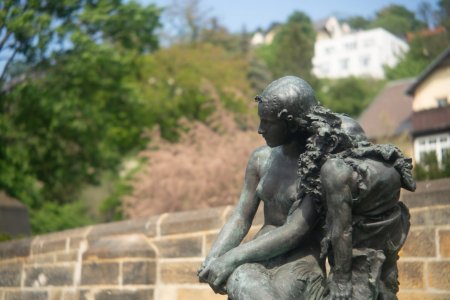
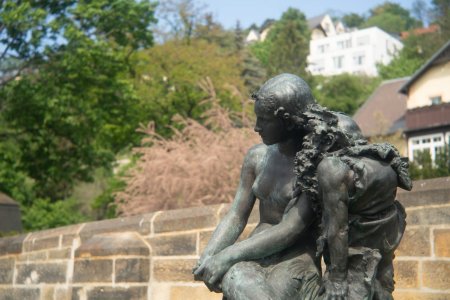
Sonnar 5cm F/1,5 at @1,5 @2 @2,8 @5,6




Sonnar 5,8cm F/2 at @2 @2,8 @5,6
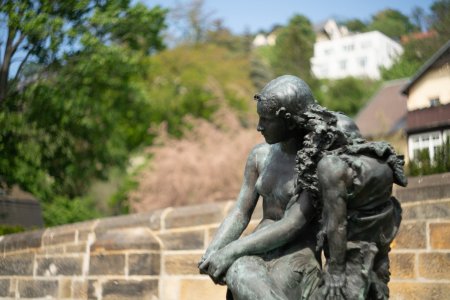


I tried to visualize this effect. I compared my Sonnar 5,8cm f/1,5 with a wartime LTM Sonnar 5cm f/1,5 and a post-war Biotar 5,8cm f/2.



For this test I stood in front of a large black and white picture and did 5 images at 5 different focus positions. From totally out of focus the lens focused on far away to in-focus and then to totally out-of focus focused very close.
a -> lens focused almost to infinity, b -> focus almost achieved, c -> in focus, d -> focused closer than in focus, e -> lens focused very close
You can clearly see that at point c (the in-focus point) the Sonnar 5,8cm is visibly softer than the focused before and after this focus point. Believe me this is no shake or misfocus. The out-of-focus area on the close side looks suspicious too. Does anyone have an explanation? Is my copy faulty?
I did some comparison shots with those 3 lenses yesterday. Here is one set.
Sonnar 5,8cm F/1,5 at @1,5 @2 @2,8 @5,6




Sonnar 5cm F/1,5 at @1,5 @2 @2,8 @5,6




Sonnar 5,8cm F/2 at @2 @2,8 @5,6



dexdog
Mentor
I have not previously seen a lens that has the odd focus issue that your lens appears to exhibit. My first guess would be one or more lens elements are not seated properly and are tilted off-axis. My next guess would be that a lens element was ground wrong at the factory. I think that the black and white picture you chose was a great way to illustrate the problem, it is harder to see the issue on the images with the statue.
Räuber
Established
The images of the statue are only to show some comparison between the classic 5cm Sonnar, the Biotar 5,8cm and this Sonnar 5,8cm.
Both 5,8cm lenses have a slight difference in focal length. The Sonnar 5,8cm is less contrasty and sharp as both lenses. The bokeh of the 5,8cm is smoother then the bokeh of the other lenses. Even at the same aperture setting the Sonnar seem to have a thinner DOF then the Biotar so the bokeh is smoother.
@dexdog
I think you are right. The issue probably comes from some glass elements misaligned. Since your Sonnar 5,8cm is sharp mine has some issues. Maybe thats the reason why it was not engraved?! The question is who is able to correct this kind of issue? I'm not sure my CLA guy will be able to fix this. And Skyllaney does not accept offers from outside UK...
Both 5,8cm lenses have a slight difference in focal length. The Sonnar 5,8cm is less contrasty and sharp as both lenses. The bokeh of the 5,8cm is smoother then the bokeh of the other lenses. Even at the same aperture setting the Sonnar seem to have a thinner DOF then the Biotar so the bokeh is smoother.
@dexdog
I think you are right. The issue probably comes from some glass elements misaligned. Since your Sonnar 5,8cm is sharp mine has some issues. Maybe thats the reason why it was not engraved?! The question is who is able to correct this kind of issue? I'm not sure my CLA guy will be able to fix this. And Skyllaney does not accept offers from outside UK...
TenEleven
Well-known
One thing that I do not quite understand with the above visualization is this: How are you achieving focus - using live view or the rangefinder?
Because if the answer is rangefinder focus then the lens might not be optically faulty but simply misaligned.
I am asking because the statue photos look okay to me. It's perhaps a bit less sharp than my copy at f/1.5 but not dramatically so. The lens might also be a slight bit hazy or have worn coating which will reduce the contrast. I would argue that a bit of a murky image at 1.5 is normal for most 1.5 Sonnars. I usually reserve opening up to f/1.5 for "emergency use" when I am really out of light. There are exceptional (war-time, late CZ) copies where f/1.5 is fully usable - but these are the minority.
Also the Biotar has more apparent depth of field for two reasons: 1) It has quite strong optical vignetting in the corners which also gives its its "trademark" cat's eye swirly bokeh. 2) The area of good focus curves backwards like a soup plate away from the photographer into the field. The latter was done on purpose and the field curvature was accepted by Merte as a trade-off in order to bend flare away from the inside of the lens to avoid image-destroying internal reflections. This was originally for the un-coated versions, but Zeiss apparently never bothered to do a major design revision after coatings became common. The 4cm shares both of these traits by the way. It's what makes it a Biotar and not a Planar..
Because if the answer is rangefinder focus then the lens might not be optically faulty but simply misaligned.
I am asking because the statue photos look okay to me. It's perhaps a bit less sharp than my copy at f/1.5 but not dramatically so. The lens might also be a slight bit hazy or have worn coating which will reduce the contrast. I would argue that a bit of a murky image at 1.5 is normal for most 1.5 Sonnars. I usually reserve opening up to f/1.5 for "emergency use" when I am really out of light. There are exceptional (war-time, late CZ) copies where f/1.5 is fully usable - but these are the minority.
Also the Biotar has more apparent depth of field for two reasons: 1) It has quite strong optical vignetting in the corners which also gives its its "trademark" cat's eye swirly bokeh. 2) The area of good focus curves backwards like a soup plate away from the photographer into the field. The latter was done on purpose and the field curvature was accepted by Merte as a trade-off in order to bend flare away from the inside of the lens to avoid image-destroying internal reflections. This was originally for the un-coated versions, but Zeiss apparently never bothered to do a major design revision after coatings became common. The 4cm shares both of these traits by the way. It's what makes it a Biotar and not a Planar..
Last edited:
Give the lens a "shake test", if an element is loose- you will hear it. Learned that less doing a CLA on my 272 Wartime LTM Sonnar 5cm F1.5: the middle triplet was use, explaining why it had such little use.
I have the Contax mount of the lens- and focus at distance is sharp enough, nit as good as the 5cm F1.5.
 F-Stop key: F1.5 and F4, despite what the exif indicates.
F-Stop key: F1.5 and F4, despite what the exif indicates.
I have the Contax mount of the lens- and focus at distance is sharp enough, nit as good as the 5cm F1.5.

Räuber
Established
The shake-test was ok. There was nothing to hear. Seems solid like a stone.
I use my lenses on a Sony A7 RIII. The 42MP extract all the details. When focusing I mostly use the zoomed in live view in the EVF. The zoom is very high, further magnified by the high MP count. So what I see in the digital viewfinder is like the final image 200% magnified. So I know pretty well how a Sonnar behaves when focusing. When I first used a Sonnar 5cm I was amazed how it goes from an area with green fringing to an area of magenta wringing. The point of maximum sharpness, when your subject is in focus, is the point where you can not see either green nor magenta outlining (in the viewfinder). That was the point where I noticed how the creator of this lens balanced 2 sides of an optical issues to achieve best contrast and sharpness. I'm still struggle with all the theory behind it. But a lot of people mention this how the point of best focus was clearly visible with a Sonnar lens when focusing.
My 5,8cm Sonnar is not the worst lens but compared with the classic 5cm Sonnar it is no match. You can look at the comparison shot of the 5cm f/1,5 and the 5,8cm Sonnar at f/1,5. The 5cm is way ahead of the 5,8cm. When using the 5,8cm you will not notice the issue that much. At f1,5 and f2 it is to soft to clearly see the point of best focus. I noticed it only when I try to focus on a flat subject like a picture that something is off and different to other lenses.
When you look at the black & white samples you notice the strangeness especially in picture (e) of the Sonnar 5,8cm. It should look similar to picture (a). But you can still see the details of the image and there are no double outlines. When I took this photo I focused very close but the lens resisted to get blurry and show those typical double outlines. The image gets soft nevertheless but while I have the typical double outlines on the infinity end there is only gaussian softness when you focus close. This might be an interesting feature but I doubt that this is intended. I was hoping someone knows this effect and knows whats up with the lens.
I will do some decentering tests. Maybe it helps me to see what is going on.
I use my lenses on a Sony A7 RIII. The 42MP extract all the details. When focusing I mostly use the zoomed in live view in the EVF. The zoom is very high, further magnified by the high MP count. So what I see in the digital viewfinder is like the final image 200% magnified. So I know pretty well how a Sonnar behaves when focusing. When I first used a Sonnar 5cm I was amazed how it goes from an area with green fringing to an area of magenta wringing. The point of maximum sharpness, when your subject is in focus, is the point where you can not see either green nor magenta outlining (in the viewfinder). That was the point where I noticed how the creator of this lens balanced 2 sides of an optical issues to achieve best contrast and sharpness. I'm still struggle with all the theory behind it. But a lot of people mention this how the point of best focus was clearly visible with a Sonnar lens when focusing.
My 5,8cm Sonnar is not the worst lens but compared with the classic 5cm Sonnar it is no match. You can look at the comparison shot of the 5cm f/1,5 and the 5,8cm Sonnar at f/1,5. The 5cm is way ahead of the 5,8cm. When using the 5,8cm you will not notice the issue that much. At f1,5 and f2 it is to soft to clearly see the point of best focus. I noticed it only when I try to focus on a flat subject like a picture that something is off and different to other lenses.
When you look at the black & white samples you notice the strangeness especially in picture (e) of the Sonnar 5,8cm. It should look similar to picture (a). But you can still see the details of the image and there are no double outlines. When I took this photo I focused very close but the lens resisted to get blurry and show those typical double outlines. The image gets soft nevertheless but while I have the typical double outlines on the infinity end there is only gaussian softness when you focus close. This might be an interesting feature but I doubt that this is intended. I was hoping someone knows this effect and knows whats up with the lens.
I will do some decentering tests. Maybe it helps me to see what is going on.
TenEleven
Well-known
One easy way to check for de-centering is how the spherical aberration (glow) behaves relative to highlights. Obviously the glow should be centered around the origin source. You will notice that even on good lenses it shifts left/right- and up/downwards a bit as you traverse the frame. That is normal. However it should be fairly centered on the image axis. You can cut holes in a black sheet of paper and illuminate it from behind to make these faults extra visible.
Bad de-centering can also look as if lens tilt has been applied. I had a war-time Sonnar where the left side of the image field (right lens side) was tilted towards the imaging plane. Not the worst since depth-of-field is deeper towards the back and stopping down mostly hid the flaw, but definitely noticeable, even on film. I re-mounted the lens into a new mount and focus helical, but the flaw remained - pointing to an optical issue.
Other centering or inter-element issues I have seen can manifest as something that seems to be astigmatism, an aberration Sonnar lenses are famously free of, giving them their trademark "pleasing look". It looks a bit like camera shake (any direction) except that it will be increasingly present off-axis and of course using a tripod or faster shutter speeds will not make it go away. Closing the aperture however will.
Bad de-centering can also look as if lens tilt has been applied. I had a war-time Sonnar where the left side of the image field (right lens side) was tilted towards the imaging plane. Not the worst since depth-of-field is deeper towards the back and stopping down mostly hid the flaw, but definitely noticeable, even on film. I re-mounted the lens into a new mount and focus helical, but the flaw remained - pointing to an optical issue.
Other centering or inter-element issues I have seen can manifest as something that seems to be astigmatism, an aberration Sonnar lenses are famously free of, giving them their trademark "pleasing look". It looks a bit like camera shake (any direction) except that it will be increasingly present off-axis and of course using a tripod or faster shutter speeds will not make it go away. Closing the aperture however will.
TenEleven
Well-known
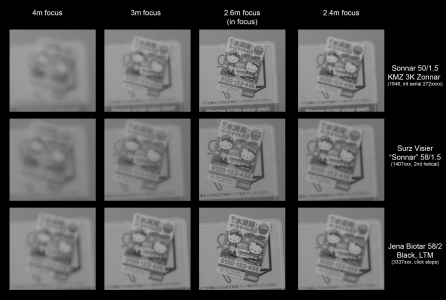
(Click through for full image - LARGE file 8mb!)
I quickly did the same thing Räuber has done with a similar set of three lenses on a Nex5N (16.1Mpix APS-C) it obviously has less resolution than the camera he is using but it being APS-C makes up for some of that providing the equivalent of a full-frame 36.6Mpix image in the central portion. the images provided are a 100% central crop of the RAW. De-saturated, no other post processing done. Focus was done using maximally magnified live-view with several attempts coming in from either direction to achieve best possible focus.
All lenses at maximum open mechanical aperture; aka turn to open until I hit the hard stop.
Camera was on AE and due to the lower contrast of the 58mm Sonnar chose a slightly slower exposure for that lens.
A couple of observations:
- The 58mm Sonnar is the sharpest, followed by the 50mm Sonnar then tied with the 58mm Biotar
- The 58mm Sonnar focal length seems to be pretty exactly 58mm if we can believe the Biotar to be the 58mm stated
- The 58mm Sonnar has the lowest contrast, the 50mm Sonnar has more contrast and the Biotar has the highest contrast
- The Biotar has the largest apparent depth of field
- Astigmatism in the Biotar reduces some apparent sharpness
- The 50mm Sonnar has the typical double-ringing artifact for out of focus areas, the 58mm has much less and the Biotar has none however the out-of-focus looks a bit shaken due to the aforementioned astigmatism
Last edited:
TenEleven
Well-known

Here's a quick lazy "blinker" comparison I made to illustrate this point. I down-sized the 58mm image to match. The 50mm image is still at 100%. I matched the exposure by bringing up the 58mm by 1/3 stop in post. I know that down-sizing the 58mm image to match has a bunch of caveats, but I am not writing a scientific paper here. I want to illustrate the sharpness/contrast difference between.
Also apparently different color/spectral response? Interesting....
Räuber
Established
I don't know if you are familiar with this 2018 report from a Japanese CLA specialist. Very detailed insight in the construction and thoughts behind the Sonnar 5,8cm f/1,5 lens. There is even a lens design made from the lenses when taken apart. If I compare this to the Stuvi drawings from Marco Cavina and I would say we can take the Stuvi theory for granted. For me the Sonnar 5,8cm f/1,5 is a rehoused Sonnar lens from bomb sights.
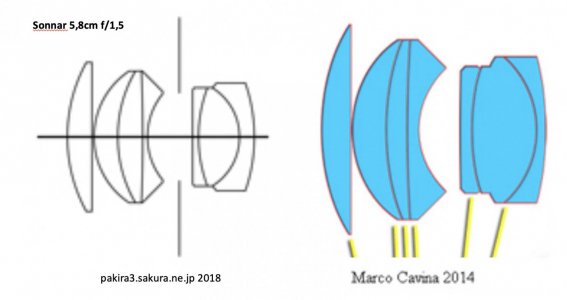
One remaining question is who calculated the optics and when. There is a prototype in the books of Zeiss Ikon Dresden for a Sonnar 5,8cm f/1,5cm dating to 1947. But this would be way to late for this lens to be used during WWII in the Stuvi 5. Then there is this article from the Photo Magazin 1949 stating that the first lenses showed up a year ago (in 1948).
The linked article has a lot of details that might be especially useful for our experts that take Sonnar lenses apart. Maybe you can find some additional hints to the origin of the lenses body in there.
What I found interesting is the statement that the aluminum work hints to an even later time in the late 60ies. Since we know that Zeiss did not invent time travels (not that I know of) there should be another explanation. The manufacturer was way ahead of its time when it comes to aluminum processing. But he lacked experience in lens manufacturing. The lens body design is very simple and not as sophisticated as the CZJ lens designs of the war time. The whole lens body construction seems to be one of a kind.
So the question remains who had the skills to create this kind of mechanical solution shown in the lens body? The other fact you should keep in mind is that there are not only LTM bodies. There are Contax bodies too. Those bodies mimic the usual Chrome and even black Nickel Sonnar bodies. So it was a manufacturer that was able to mimic even the black Nickel Sonnars.

One remaining question is who calculated the optics and when. There is a prototype in the books of Zeiss Ikon Dresden for a Sonnar 5,8cm f/1,5cm dating to 1947. But this would be way to late for this lens to be used during WWII in the Stuvi 5. Then there is this article from the Photo Magazin 1949 stating that the first lenses showed up a year ago (in 1948).
The linked article has a lot of details that might be especially useful for our experts that take Sonnar lenses apart. Maybe you can find some additional hints to the origin of the lenses body in there.
What I found interesting is the statement that the aluminum work hints to an even later time in the late 60ies. Since we know that Zeiss did not invent time travels (not that I know of) there should be another explanation. The manufacturer was way ahead of its time when it comes to aluminum processing. But he lacked experience in lens manufacturing. The lens body design is very simple and not as sophisticated as the CZJ lens designs of the war time. The whole lens body construction seems to be one of a kind.
So the question remains who had the skills to create this kind of mechanical solution shown in the lens body? The other fact you should keep in mind is that there are not only LTM bodies. There are Contax bodies too. Those bodies mimic the usual Chrome and even black Nickel Sonnar bodies. So it was a manufacturer that was able to mimic even the black Nickel Sonnars.
dexdog
Mentor
That guy does amazing work. I bookmarked his site a few months ago. There is a 6cm Sonnar currently on eBay. It is different than others I have seen in that the aperture and focus directions are backwards.


Zeiss Sonnar 6cm F1.5 L-39 SM Unusual Rare Lens with Caps | eBay
I believe made in East Germany.
www.ebay.com
Last edited:
The article by the Japanese Master Repair Artist is wonderful. Easy to state that the optics are the same as my Contax mount lens, but the barrel is very different. My lens uses 40mm filters, and the aperture ring is separate from the fixture for the front element.
The Aperture blades on mine look the same as those in the article. I have seen this same material used in some 5cm F1.5 Transition Sonnars.
Also: I still have the opinion that someone chose the 140xxxx Serial Numbers for "Leica Sonnar" and others like this intentionally, knowing this is the serial number range used for the prototype LTM Sonnars made in the 1930s. "Coincidence? I Don't Think So!"
The Aperture blades on mine look the same as those in the article. I have seen this same material used in some 5cm F1.5 Transition Sonnars.
Also: I still have the opinion that someone chose the 140xxxx Serial Numbers for "Leica Sonnar" and others like this intentionally, knowing this is the serial number range used for the prototype LTM Sonnars made in the 1930s. "Coincidence? I Don't Think So!"
Last edited:
Share:
-
This site uses cookies to help personalise content, tailor your experience and to keep you logged in if you register.
By continuing to use this site, you are consenting to our use of cookies.

